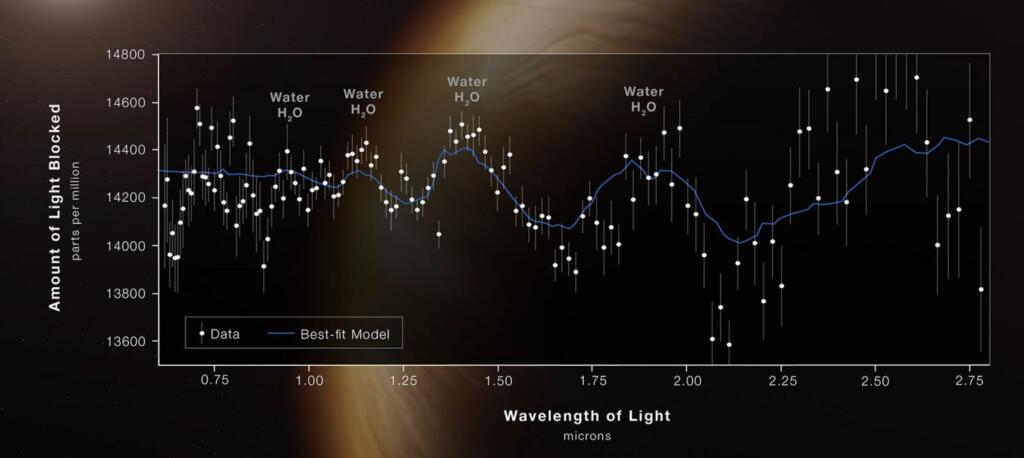James Webb Space Telescope is capable of detecting some chemical biosignatures of some Earthlike exoplanet worlds. Previously, this could only be done with Jupiter sized exoplanets that would be completely incapable of supporting life.
Researchers simulated atmospheric conditions for five broad types of Earth-like worlds: an ocean world, a volcanically active world, a rocky world during the high bombardment period, a super-Earth, and a world like Earth when life arose. They assumed all these worlds had a surface pressure of less than 5 Earth atmospheres, and calculated the absorption spectra for several organically produced molecules such as methane, ammonia, and carbon monoxide. These molecules can also be formed by non-biological methods, but they form a good baseline as a proof of concept.
Prebiosignatures on five classes of terrestrial planet: an ocean planet, a volcanic planet, a post-impact planet, a super-Earth, and an early Earth can be detected. Using a novel modeling and detection test pipeline, with simulated JWST noise, they find the detection thresholds of hydrogen cyanide (HCN), hydrogen sulfide (H2S), cyanoacetylene (HC3N), ammonia (NH3), methane (CH4), acetylene (C2H2), sulfur dioxide (SO2), nitric oxide (NO), formaldehyde (CH2O), and carbon monoxide (CO) in a variety of low mean molecular weight (<5) atmospheres. They test the dependence of these detection thresholds on M dwarf target star and the number of observed transits, finding that a modest number of transits (1-10) are required to detect prebiosignatures in numerous candidate planets, including TRAPPIST-1e with a high mean molecular weight atmosphere. They find that the NIRSpec G395M/H instrument is best suited for detecting most prebiosignatures.












Brian Wang is a Futurist Thought Leader and a popular Science blogger with 1 million readers per month. His blog Nextbigfuture.com is ranked #1 Science News Blog. It covers many disruptive technology and trends including Space, Robotics, Artificial Intelligence, Medicine, Anti-aging Biotechnology, and Nanotechnology.
Known for identifying cutting edge technologies, he is currently a Co-Founder of a startup and fundraiser for high potential early-stage companies. He is the Head of Research for Allocations for deep technology investments and an Angel Investor at Space Angels.
A frequent speaker at corporations, he has been a TEDx speaker, a Singularity University speaker and guest at numerous interviews for radio and podcasts. He is open to public speaking and advising engagements.


I know it’s wacky but I seriously wonder if they ever built that telescope at all. The first pictures they sent out “supposedly” from the JWT appeared to be fake. The rays from diffraction from the supports were the wrong number for the supports on the telescope. Maybe you think I’m a nut, but I seriously have that little faith in the US government to tell the truth. They spent over $40 billion on the SLS rocket program and, only after Musk shamed them so bad they HAD to act, launched one rocket. I think they just stole all the money. They could have done the same for Webb. How would you know if they did?
Look at this link. There are 8 rays coming off the stars. All other pictures show 6. How can this happen? Is it possible? This was one of the first pictures sent out. Some pictures had 6, some 8.
https://blogs.nasa.gov/webb/2022/05/09/miris-sharper-view-hints-at-new-possibilities-for-science/
Now later pictures from the same instrument show 6.
This image provided by NASA shows Stephan’s Quintet, a visual grouping of five galaxies captured by the Webb Telescope’s Mid-Infrared Instrument (MIRI)
https://images.hindustantimes.com/img/2022/07/12/550×309/SPACE-EXPLORATION-TELESCOPE-4_1657641175141_1657641175141_1657642757192_1657642757192.JPG
https://www.hindustantimes.com/photos/news/nasa-releases-new-set-of-images-from-james-webb-telescope-101657642630264-2.html
How did that happen? So the supports are moving around and changing their numbers at different times????
And yes I do believe we went to the Moon.
Glad that it works, otherwise it would be disaster. Class of 30 m telescopes with way more light collecting ability are unfortunately delayed. From initial estimations 2024 to 2029 or later.
Is is really so hard to do any meaningful project on time or what? Delays, delays and delays. And not just few years, often 5 or 10.
Is it because it is not private project and so they take things more easily, are not paid for efficiency and speed? Or just plain counterproductive bureaucracy, tons of permits and meetings? Or is it because there are so many subcontractors and few of them fu** it up and then everything needs to be delayed.
Please STOP saying “Earth-like” when “Earth-sized” or “Earth mass” would be much more accurate. (Pet peeve I see everywhere in space reporting nowadays.)
No kidding
What an amazing piece of technology, and from now on, each day, we are only getting more advanced (technologically)